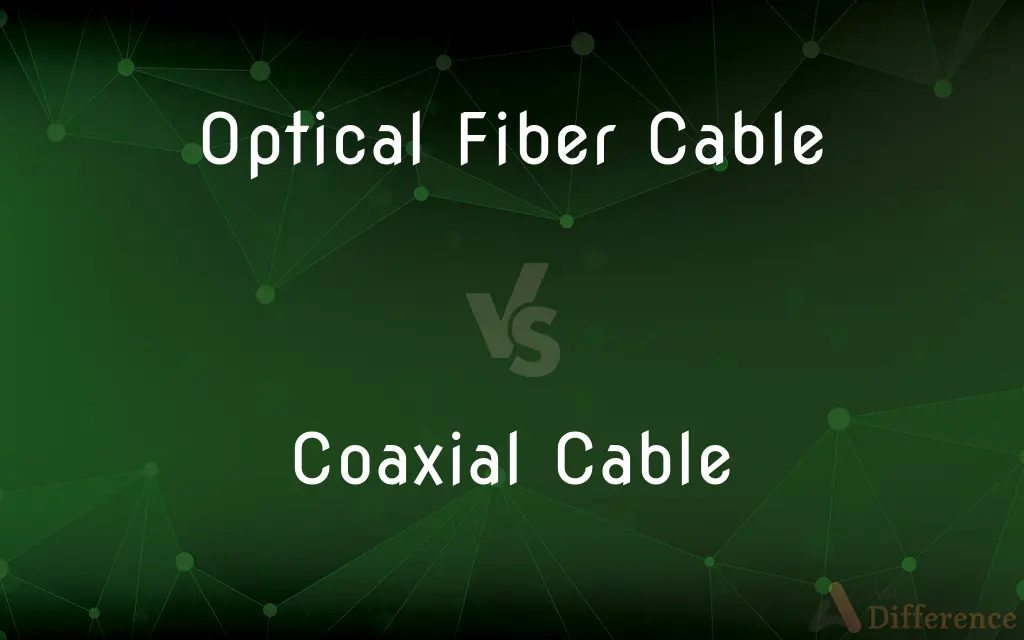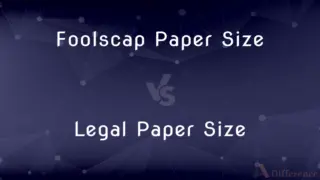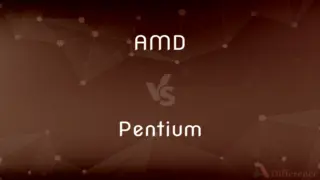Optical Fiber Cable vs. Coaxial Cable — What's the Difference?
By Tayyaba Rehman & Fiza Rafique — Published on February 7, 2024
Optical fiber cable uses light to transmit data at high speeds over long distances, while coaxial cable uses electrical signals over copper wire, suitable for shorter distances.

Difference Between Optical Fiber Cable and Coaxial Cable
Table of Contents
ADVERTISEMENT
Key Differences
Optical fiber cable and coaxial cable are two types of cables used for transmitting data. Optical fiber cable uses light to transmit data through strands of glass or plastic fibers, allowing for high-speed data transmission over long distances without significant signal loss. Coaxial cable, in contrast, transmits data through a copper conductor, encased in an insulating layer and a metallic shield, more commonly used for shorter-distance applications like cable television and internet services.
When it comes to data transmission speeds and bandwidth, optical fiber cable generally outperforms coaxial cable. The high-speed capabilities of optical fiber are due to the use of light, which can carry more data at faster speeds compared to the electrical signals used in coaxial cables. Coaxial cable, while reliable, is limited in bandwidth and speed compared to optical fiber, making it less suitable for high-bandwidth applications like fiber-optic internet.
In terms of durability and susceptibility to interference, optical fiber cables are less prone to electromagnetic interference (EMI) and radio frequency interference (RFI), making them ideal for environments with high electrical noise. Coaxial cables, although designed with shielding to minimize interference, are still more susceptible to EMI and RFI compared to fiber optics. This makes optical fiber a better choice for consistent performance in industrial and high-interference areas.
Installation and maintenance of these cables also differ. Optical fiber cables require specialized skills and equipment for installation and repair, often making them more expensive to install and maintain. Coaxial cables are easier to install and more familiar to technicians, reducing installation and maintenance costs. However, the longer lifespan and higher capacity of optical fiber can offset these initial costs over time.
Regarding versatility and use cases, optical fiber cable is predominantly used in telecommunications, internet backbone infrastructure, and high-speed data networks, excelling in long-distance and high-capacity data transmission. Coaxial cable is widely used in residential and commercial applications for cable television, internet services, and short-range data communications, offering a cost-effective solution for these applications.
ADVERTISEMENT
Comparison Chart
Data Transmission
Uses light for high-speed, long-distance transmission
Uses electrical signals, suitable for shorter distances
Bandwidth
Higher bandwidth, supporting greater data volumes
Lower bandwidth compared to optical fiber
Interference
Less susceptible to EMI and RFI
More prone to EMI and RFI
Installation
Requires specialized skills, higher initial cost
Easier to install, lower initial cost
Common Uses
Telecommunications, high-speed networks
Cable TV, internet services, short-range data communications
Compare with Definitions
Optical Fiber Cable
Requires specialized installation and maintenance.
Installing optical fiber cable in the new building was a specialized task.
Coaxial Cable
Can be affected by electromagnetic interference.
The coaxial cable’s signal was disrupted by nearby electrical equipment.
Optical Fiber Cable
Used for high-speed, high-capacity data transmission.
Optical fiber cable supports our extensive data center network.
Coaxial Cable
A type of cable with a copper conductor and metallic shielding.
The home theater system was connected with coaxial cable.
Optical Fiber Cable
Resistant to electromagnetic interference.
Optical fiber cable was chosen for its reliability in the industrial environment.
Coaxial Cable
Commonly used for cable TV and internet connections.
The technician installed coaxial cable for our cable internet service.
Optical Fiber Cable
A cable that transmits data as light through glass or plastic fibers.
The company upgraded to optical fiber cable for faster internet speeds.
Coaxial Cable
Prone to signal loss over longer distances.
For shorter runs, we use coaxial cable in our network setup.
Optical Fiber Cable
Ideal for long-distance data transmission.
The transatlantic communication relies on optical fiber cable.
Coaxial Cable
Easier to install compared to optical fiber.
Coaxial cable was quickly installed across the office for internet access.
Common Curiosities
Can coaxial cable be used for high-speed internet?
Yes, but it may not offer speeds as high as optical fiber.
Can optical fiber cable be used for residential internet?
Yes, it's increasingly used for high-speed residential internet services.
Are coaxial cables resistant to interference?
They have shielding but are still more prone to interference than optical fiber.
Do optical fiber cables require regular maintenance?
They require less maintenance than coaxial cables due to their durability.
How does distance affect optical fiber cable performance?
Optical fiber maintains signal quality over much longer distances than coaxial.
Can optical fiber cable support multiple services?
Yes, it can carry multiple types of data and services simultaneously.
Is coaxial cable still used for network infrastructure?
It's used, but increasingly being replaced by optical fiber in many networks.
Is optical fiber cable expensive to install?
Yes, due to specialized installation and equipment required.
What is the main advantage of optical fiber cable?
Its ability to transmit data at high speeds over long distances with minimal signal loss.
Are coaxial cables easy to repair?
Yes, repairs are generally simpler and less costly than optical fiber.
Is coaxial cable suitable for industrial environments?
It can be used, but optical fiber is often preferred due to its resistance to interference.
Can coaxial cable carry digital signals?
Yes, it's commonly used for digital TV and internet signals.
Is optical fiber affected by weather conditions?
It's largely unaffected by weather, unlike some types of coaxial cable.
What's the maximum distance for coaxial cable without signal loss?
Typically around 100 meters, but it can vary based on cable quality and signal type.
Are there different types of optical fiber cables?
Yes, including single-mode and multi-mode, each suited for different applications.
Share Your Discovery

Previous Comparison
Foolscap Paper Size vs. Legal Paper Size
Next Comparison
AMD vs. PentiumAuthor Spotlight
Written by
Tayyaba RehmanTayyaba Rehman is a distinguished writer, currently serving as a primary contributor to askdifference.com. As a researcher in semantics and etymology, Tayyaba's passion for the complexity of languages and their distinctions has found a perfect home on the platform. Tayyaba delves into the intricacies of language, distinguishing between commonly confused words and phrases, thereby providing clarity for readers worldwide.
Co-written by
Fiza RafiqueFiza Rafique is a skilled content writer at AskDifference.com, where she meticulously refines and enhances written pieces. Drawing from her vast editorial expertise, Fiza ensures clarity, accuracy, and precision in every article. Passionate about language, she continually seeks to elevate the quality of content for readers worldwide.
















































